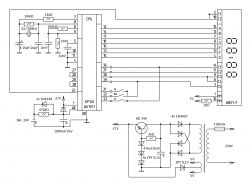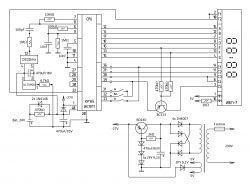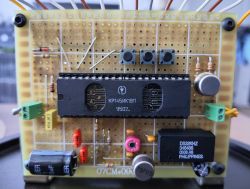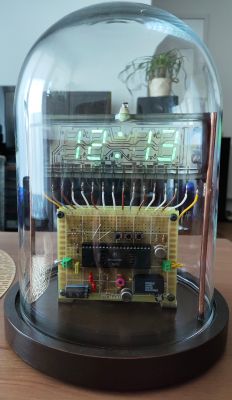Clock with VFD display IVL1-7/5 based on KR145IK1911 and DS32kHz
The increasing popularity of VFD displays, their relatively low price and interesting appearance prompted me to build a clock based on such a display.
The heart of the clock is one of the oldest specialized Soviet microcircuits for electronic clocks, made in the p-MOS technology КР145ИК1911 (KR145IK1911) in a 40-DIP housing. The system can control external devices or simply serve as an alarm clock and timer. I did not use these functions in my solution. The whole thing was assembled on a universal printed circuit board.
The power section remained on the original board from the damaged clock. The КР145ИК1911 microcircuit requires a -27V DC power supply, which comes from a stabilizer based on a rectifier bridge, zener diodes and a transistor. A low-power transformer with two secondary windings is used, one to obtain a voltage of -27V and the other to obtain an alternating filament voltage of 5V. Since the display heating circuit is also the cathode, the transformer has a tap in the middle of the winding. In order to extend the life of the display, the glow voltage is reduced to approximately 4.8V. The clock is also equipped with a main oscillator maintenance system based on two A23 batteries connected in series.
A seven-segment digital code is generated at the outputs of the microcircuit 12-18. The VFD display ИВЛ1-7/5 (IVL1-7/5) with multiplex control is used to indicate the numbers. Signals from the КР145ИК1911 system control the potential of the anodes of individual digits and service characters, ensuring their alternate activation. Only one digit is displayed at a time, but the transition from one digit to another occurs at a frequency of 500 Hz, which makes the digits on the display appear to be continuous to our eyes. The display`s service characters (dots) are flashed by giving a 1Hz signal from output 22. The clock also has a blanking function that does not indicate zero when displaying single-digit hours, based on the BC313 transistor and two resistors.
The main oscillator is located inside the microcircuit and connected to a standard watch quartz crystal resonator with a frequency of 32.768kHz. The oscillator was initially connected to a resonator system and two 20pF capacitors. However, its accuracy was not satisfactory, as I wrote about here: https://www.elektroda.pl/rtvforum/topic3852502.html.
Therefore, I decided to add additional capacity to the system in the form of a 4.2-20pF trimmer capacitor. Despite numerous attempts to adjust the frequency and replace the capacitors with slightly larger capacity (22pF), I decided to look for a different solution.
Original version of the clock:

Finally, I used a specialized DS32kHz circuit from Dallas as an oscillator, which is a temperature-compensated crystal oscillator (TCXO) with an output frequency of 32.768kHz. It is powered by the UL75P05 stabilizer with a voltage of 5V, the system also has a power supply backup based on the reserve power supply of the main oscillator of the КР145ИК1911 system. The DS32kHz system used, according to the manufacturer, has a deviation of ±2ppm, which results in ±1 minute / year (0.17 seconds / day). The system works perfectly, the clock is very accurate. Currently, after three months of continuous operation of the clock, the deviation from real time was approximately +0.03 seconds/day (+0.9 seconds/month), which gives an accuracy of ±0.3 ppm! After a year of trouble-free operation, the deviation was 6 seconds.
According to the manufacturer`s data sheet, to obtain greater running stability, it is worth powering the DS32kHz system with a voltage close to 5V (preferably about 4.9V), as you can see, it gives very good results.
The UL75P05 voltage stabilizer and the BC313 transistor used come from the era and are manufactured by the Polish CEMI, made in TO39 metal "hat" housings.
Final wiring diagram:

Plate:

Clock appearance:

The heart of the clock is one of the oldest specialized Soviet microcircuits for electronic clocks, made in the p-MOS technology КР145ИК1911 (KR145IK1911) in a 40-DIP housing. The system can control external devices or simply serve as an alarm clock and timer. I did not use these functions in my solution. The whole thing was assembled on a universal printed circuit board.
The power section remained on the original board from the damaged clock. The КР145ИК1911 microcircuit requires a -27V DC power supply, which comes from a stabilizer based on a rectifier bridge, zener diodes and a transistor. A low-power transformer with two secondary windings is used, one to obtain a voltage of -27V and the other to obtain an alternating filament voltage of 5V. Since the display heating circuit is also the cathode, the transformer has a tap in the middle of the winding. In order to extend the life of the display, the glow voltage is reduced to approximately 4.8V. The clock is also equipped with a main oscillator maintenance system based on two A23 batteries connected in series.
A seven-segment digital code is generated at the outputs of the microcircuit 12-18. The VFD display ИВЛ1-7/5 (IVL1-7/5) with multiplex control is used to indicate the numbers. Signals from the КР145ИК1911 system control the potential of the anodes of individual digits and service characters, ensuring their alternate activation. Only one digit is displayed at a time, but the transition from one digit to another occurs at a frequency of 500 Hz, which makes the digits on the display appear to be continuous to our eyes. The display`s service characters (dots) are flashed by giving a 1Hz signal from output 22. The clock also has a blanking function that does not indicate zero when displaying single-digit hours, based on the BC313 transistor and two resistors.
The main oscillator is located inside the microcircuit and connected to a standard watch quartz crystal resonator with a frequency of 32.768kHz. The oscillator was initially connected to a resonator system and two 20pF capacitors. However, its accuracy was not satisfactory, as I wrote about here: https://www.elektroda.pl/rtvforum/topic3852502.html.
Therefore, I decided to add additional capacity to the system in the form of a 4.2-20pF trimmer capacitor. Despite numerous attempts to adjust the frequency and replace the capacitors with slightly larger capacity (22pF), I decided to look for a different solution.
Original version of the clock:

Finally, I used a specialized DS32kHz circuit from Dallas as an oscillator, which is a temperature-compensated crystal oscillator (TCXO) with an output frequency of 32.768kHz. It is powered by the UL75P05 stabilizer with a voltage of 5V, the system also has a power supply backup based on the reserve power supply of the main oscillator of the КР145ИК1911 system. The DS32kHz system used, according to the manufacturer, has a deviation of ±2ppm, which results in ±1 minute / year (0.17 seconds / day). The system works perfectly, the clock is very accurate. Currently, after three months of continuous operation of the clock, the deviation from real time was approximately +0.03 seconds/day (+0.9 seconds/month), which gives an accuracy of ±0.3 ppm! After a year of trouble-free operation, the deviation was 6 seconds.
According to the manufacturer`s data sheet, to obtain greater running stability, it is worth powering the DS32kHz system with a voltage close to 5V (preferably about 4.9V), as you can see, it gives very good results.
The UL75P05 voltage stabilizer and the BC313 transistor used come from the era and are manufactured by the Polish CEMI, made in TO39 metal "hat" housings.
Final wiring diagram:

Plate:

Clock appearance:




Comments
Revelation. I associate VFD displays with a Russian watch and video recorder. In my life, I would not have thought that the fashion for these rather cold displays would come back ;) A great idea for the... [Read more]
Great idea for the housing and execution under it. I have seen and still have a lot of Russian systems, and this one is interesting because of these two windows. Are they for something or something? [Read more]
Good question, what are these "windows" in KR145IK1911 for. It is interesting because this microcircuit was produced in a version without and with "windows" (I have both types). Looking at the production... [Read more]
Those who remember this "system" know that there was simply no (after all, everything was still missing at that time) proper housings, so they were loaded with windows that were supposed to be, for example,... [Read more]
It will be 15 years since I was struggling with the same problem in my NIXIE clock. And I solved the same problem, now I don't adjust this watch more than twice a year (on the occasion of the time... [Read more]
It came to my mind :) Knowing a bit of material shortages in Comecon, it could be that such cases were at hand, but I couldn't find Soviet EPROMs with two windows. Maybe there will be someone on the... [Read more]
A very interesting idea and an aesthetic and original effect. I remember DS32kHz from Dallas / Maxim even before the merger with Analog Devices. Where did you buy the DS32kHz? Is there anything with... [Read more]
Colleague robig with his post encouraged me to do a little investigation :) First of all, I found out who is the manufacturer of this particular copy of the ??145??1911 microcircuit. It is the Ukrainian... [Read more]
I was intrigued by the described circuit (KR145IK1911) and I would love to build a clock based on it. Unfortunately, the availability of this Soviet technological marvel is minimal :P Where can I get some... [Read more]
I think a slightly better effect would be if this glass or plastic dome was made of slightly smoked glass. Green or blue. The readability of the display would also improve during the day. [Read more]
The USSR had unusual logic systems, with no counterparts in Western countries. If a friend also takes a look, this system is inserted into the socket "by force" because the pins slightly do not match the... [Read more]
There is a seller (company) from Germany on Ebay. Search for "KR145IK1911 vfd nixie clock driver". Systems in the version with windows for the price of 9.99 euros + 6 euros shipping. I just bought 2... [Read more]
Interestingly, VFD was used in a quite modern and mass product - nbox set-top boxes. Alphanumeric FVD display: https://www.elektroda.pl/rtvforum/topic3762233.html Heavily used set-top boxes showed signs... [Read more]
I really like VFD displays, they have their own charm, especially when they have a purple filter installed, which provides a visually pleasing blue color of the displayed characters (which cannot be said... [Read more]
Thanks a lot. I bought a DS32kHz here on the lead. Post the best advertisement that you are looking for this arrangement. Someone will surely report. Added after 7 [minutes]: It's hard... [Read more]
It will probably be so light from 11 years of regular use of this Scythe Kaze Master Pro fan controller. https://obrazki.elektroda.pl/6784437600_1667154362_thumb.jpg You can see the uneven burnout... [Read more]
VFD displays are still manufactured and used today. Unfortunately, they are expensive - graphic 128x64 is several hundred zlotys. And why is it worth using them? Firstly, fantastic resistance to temperatures... [Read more]
@pawelr98 what modern IC control stages would be a good bridge between a microcontroller and 30V anode voltage? Can you post a picture of the original driver board for these VFDs? They surprised me with... [Read more]
The connection was in parallel, all filaments between the negative rail and a single pin. https://obrazki.elektroda.pl/3834839600_1597540051_bigthumb.jpg This is roughly what my controls look like. ... [Read more]